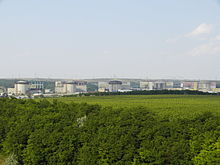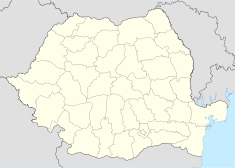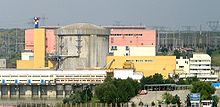- Cernavodă Nuclear Power Plant
-
Cernavodă Nuclear Power Plant 
The Cernavodă Nuclear Power PlantLocation of Cernavodă Nuclear Power Plant Country Romania Coordinates 44°19′20″N 28°03′26″E / 44.32222°N 28.05722°ECoordinates: 44°19′20″N 28°03′26″E / 44.32222°N 28.05722°E Construction began 1980s Commission date 2 December 1996 Operator(s) Nuclearelectrica Reactor information Reactors operational 2 x 700 MW Reactors planned 2 x 750 MW Power generation information Annual generation 5,178 GW·h Net generation 51,045 GW·h The Nuclear Power Plant in Cernavodă (Romanian: Centrala Nucleară de la Cernavodă) is the only nuclear power plant in Romania. It produces around 20% of the country's electricity. It uses CANDU reactor technology from AECL, using heavy water produced at Drobeta-Turnu Severin as its neutron moderator and water from the Danube – Black Sea Canal for cooling.
By using nuclear power, Romania is able to reduce its greenhouse gas emissions by over 10 million tonnes each year.[citation needed]
The power plant was designed in Canada by Atomic Energy of Canada Limited in the 1980s, during the Communist era. The initial plan was to build five units.
Units 1 and 2 are currently fully operational. Three more partially completed CANDU reactors exist on the same site, part of a project discontinued at the close of the Nicolae Ceauşescu regime. Units 3 and 4 are in their planning stages, with expected completion dates of 2014 and 2015 respectively.
CNE-INVEST is responsible for the preservation of Units 3-5.
Contents
Reactors
Unit 1
Unit 1, a CANDU 6-type, was finished in 1996 and produces 705.6 MW of electricity.
It was commissioned and began operating at full power in 1996 and has had record capacity factors of 90 per cent since 2005.
Unit 2
A consortium of AECL and Ansaldo Nucleare of Italy, along with the Nuclearelectrica (SNN) SA, Romania’s nuclear public utility, was contracted in 2003 to manage the construction of the partially completed Unit 2 power plant and to commission it into service.
Four years later, Unit 2, another CANDU 6-reactor, achieved criticality on 6 May 2007 [1] and was connected to the national grid on 7 August. It began operating at full capacity on 12 September 2007[2], also producing 706MW.
Unit 2 was officially commissioned on Friday, October 5, 2007 during ceremonies attended by Romanian Prime Minister Călin Popescu-Tăriceanu and senior officials from Atomic Energy of Canada Limited (AECL). [3]. This makes CNE-Cernavoda Station the largest power producer in the country.
Future expansion
Units 3 and 4
Units 3 and 4 were expected to be CANDU 6 reactors with a similar design to Unit 2 and will each have a capacity of 740 MW. Units 3 and 4 are expected to be operational by 2016-2017.[4] The project was estimated to take up to six years after the contracts are signed.
In a feasibility study carried out by Deloitte and Touche, the most economically viable scenario would be to build the two phases at the same time, with the cost estimated at €2.3 billion.
On 20 November 2008, Nuclearelectrica, ArcelorMittal, ČEZ, GDF Suez, Enel, Iberdrola and RWE agreed to set up a joint company dedicated to the completion, commissioning and operation of Units 3 and 4. The company named Energonuclear was registered in March 2009.[5]
20th of January 2011, GDF Suez, Iberdrola and RWE pulled out of the project, following ČEZ which already left last September, citing "Economic and market-related uncertainties surrounding this project, related for the most part to the present financial crisis, are not reconcilable now with the capital requirements of a new nuclear power project"[6].
Units 5
There are currently no plans to complete Unit 5 [2] at this time. However, the possibility of finishing construction remains.
Incidents
- On 30 May 2009, Unit 1 of the Romania's Cernavoda NPP was shut down following a water pipe crack. The Cernavoda NPP's second unit was undergoing an overhaul, so it was not producing any electricity.[7]
- On 8 Apr 2009, the second reactor of the Romania's Cernavoda NPP was shut down due to a malfunction which led to electrical outages.[8]
- On Jan 16 2010, the first unit was shut down due to steam leakage.[9]
See also
References
- ^ Cernavoda 2 achieves initial criticality
- ^ Hotnews.ro, Reactorul 2 de la Cernavoda a ajuns la capacitate maxima ("The second unit at the Cernavodă Nuclear Power Plant reached at full capacity "), September 12, 2007
- ^ 2007 News Releases - Second CANDU Unit in European Union Officially In Service
- ^ www.adevarul.ro 12 February 2010: [1]
- ^ "Draft agreement finalized for Romanian reactors". World Nuclear News. 2008-03-07. http://www.world-nuclear-news.com/NN/Draft_agreement_finalized_for_Romanian_reactors_070308.html. Retrieved 2008-03-07.
- ^ rwe.com 20 January 2011: GDF SUEZ, RWE and Iberdrola have decided not to continue to participate in the Cernavoda nuclear project in Romania. See also "UPDATE 2-RWE, Iberdrola, GDF Suez exit Romania nuclear plan". Reuters. 20 January 2011. http://af.reuters.com/article/energyOilNews/idAFLDE70J0TI20110120.
- ^ Romania’s Nuclearelectrica Shuts Down Nuke Over Water Pipe Crack, Mediafax 2009-05-30
- ^ Romania's Cernavoda Nuclear Plant Restarts 2nd Reactor, Mediafax, 2009-04-09
- ^ http://www.adevarul.ro/financiar/Unitatea_1_a_centralei_de_la_Cernavoda_a_fost_oprita_0_190781275.html
External links
High Capacity Power stations in Romania (more than 100 MW installed capacity)Thermal Turceni - 2,310 MW · Rovinari - 1,420 MW · Mintia-Deva - 1,285 MW · Ișalnița - 1,035 MW · Crivina - 990 MW · Brazi - 950 MW · Petrom Brazi - 860 MW · Luduș-Iernut - 800 MW · Sărdănești - 700 MW · Borzești - 655 MW · Brăila - 646 MW · Bucharest South - 550 MW · Galați - 535 MW · Doicești - 320 MW · Bucharest West - 310 MW · Craiova II - 300 MW · Paroșeni - 300 MW · Borzești II - 250 MW · Fântânele - 250 MW · Halânga - 247 MW · Buzău - 207 MW · Oradea - 205 MW · Govora - 200 MW · Progresu - 200 MW · Alum Tulcea - 150 MW · Brazi II - 150 MW · Giurgiu - 150 MW · Iaşi I - 150 MW · Pitești Sud - 136 MW · Arad - 112 MW · Brașov - 100 MW · Grozăvești - 100 MW · Iaşi II - 100 MW · Holboca - 100 MW · Palas - 100 MW · Suceava - 100 MWHydroelectric Iron Gate I - 2,192 MW · Tarniţa - Lăpuşteşti - 1,000 MW · Iron Gate II - 591 MW · Lotru-Ciunget - 510 MW · Râul Mare - 335 MW · Mărişelu - 221 MW · Vidraru - 220 MW · Bicaz-Stejaru - 210 MW · Ruieni - 153 MW · Nehoiaşu - 152 MW · Oaşa - 150 MW · Şugag - 150 MW · Remeţi - 146 MW · Brădişor - 115 MW · Tismana - 106 MWNuclear Cernavodă Nuclear Power Plant - 1,400 MWWind farms Sinus Holding - 700 MW · Fântânele-Cogealac - 600 MW · Blackstone - 500 MW · Deleni - 500 MW · Eolica Cogealac - 448 MW · Mărişelu - 300 MW · Eolica Sǎcele - 252 MW · Eolica Casimcea - 244 MW · Văcăreni - 240 MW · Green Energy - 200 MW · Verbund Casimcea - 150 MW · Sabloal Valea Dacilor - 147 MW · EDP Cernavodă - 138 MW · Eolica Beidaud - 128 MW · Eolica Baia - 126 MW · Eolica Sarichioi - 102 MW · Gheorgheni - 100 MWCategories:- Nuclear power stations in Romania
- Constanţa County
- Nuclear power stations with reactors under construction
- Nuclear power stations using CANDU reactors
Wikimedia Foundation. 2010.



